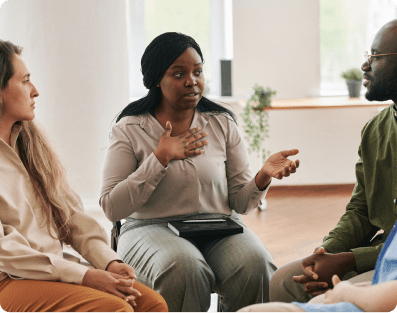Real-World Task Guidelines:
EAL Literacy
CLB 2L
Social Connections and Relationships

Possible Topics
This theme may include these topic areas:
And so on
Planning Context
Learners may require the following:
- Slower rate of speech
- Face-to-face or one-on-one digital interactions
- Short and supportive interactions
- Texts which are clear, sparse and very easy to read
- Texts which are supported by visual clues (for example, pictures)
- Very short texts which are limited to everyday words and phrases
- Non-demanding contexts
- Topics are related to immediate personal needs
Instructors may need to:
- Slow their rate of speech
- Use everyday common speech and text
- Create simplified versions of texts and audio clips/ recordings
- Modify instructions to limit to simple imperative sentences
- Use increased white-space, large font size, a literacy-friendly font and clear images
- Provide extensive scaffolding and support
Comprehending Information
Understand simple information about familiar, concrete topics.
- Identifies simple factual details, such as numbers, letters, time, place, key words and expressions.
- Identifies words related to personal identification information.
Interacting with Others
Understand greetings, introductions, requests, goodwill expressions and an expanding range of basic courtesy formulas.
Communication is very brief, 2 or 3 turns.
- Identifies common courtesy phrases and an expanding range of expressions.
- Identifies participant roles and relationships based on courtesy formulas and introductions.
Sharing Information
Give basic descriptions of concrete, familiar objects in a few short words or phrases.
- Describes concrete objects, likes and dislikes.
- Describes sizes, colours and numbers.
Getting Things Done
Make and respond to simple requests related to common everyday activities.
- Uses appropriate memorized expressions, simple sentences, and courtesy formulas for requests.
Comprehending Instructions
Understand short, simple, clearly sequenced instructions for common, familiar everyday situations.
Instructions are up to 4 steps, in point or bullet form, and may be accompanied by illustrations.
- Recognizes individual words, phrases and symbols used in simple instructions.
- Follows instructions in the proper sequence.
Getting Things Done
Get basic information from short, simple business or service notices.
- Scans text to find specific details.
- Recognizes layout.
Reproducing Information
Copy a range of information, from simple lists or very short passages, for personal use or to complete short tasks.
Texts to copy are 3 to 5 sentences, have clear layout, and basic everyday information; lists have about 10 items.
- Copies letters, numbers, words and sentences with correct capitalization and punctuation.
- Follows standard Canadian conventions and styles when copying addresses and phone numbers.
Interacting with Others
Convey an expanding range of goodwill messages by means of standard cards or guided notes.
Messages are a few words or short phrases, addressed to a familiar person and related to personally relevant situations.
- Completes a standard greeting card or a message with simple information.
- Uses adequate spelling and punctuation.
Literacy Learner Considerations
Listening and Speaking
2L learners are meeting the requirements of CLB 2 in listening and speaking. It is important for 2L learners to develop all new language orally first so that it is familiar to them when they learn to recognize it in print. Listening and speaking should be taught and assessed orally and not through the skills of reading and writing. There is a focus on increasing basic, immediately relevant vocabulary and learning the sounds of the language, along with the ability to break words into sounds and to blend sounds into words.
Reading
To be successful in 2L reading tasks, 2L learners can work towards the development of reading skills in the context of real-world tasks, such as:
- developing oral vocabulary related to the task
- using short vowel sounds to differentiate between a few short, highly familiar words
- beginning to blend sounds to read very simple words
- recognizing familiar repeated sentence stems
- developing some very basic sight words
Writing
To be successful in 2L writing tasks, 2L learners can work towards the development of writing skills in the context of real-world tasks, such as:
- developing oral vocabulary related to the task
- using a mature grip on a pencil or pen
- forming all letters and numbers with increasingly consistent size
- filling in missing initial and final sounds of dictated familiar words
- spelling own name and a small set of short, familiar function words from memory
Additional Sample Real-World Tasks and Competency Areas
Listen to instructions for what to bring to a potluck party. (Comprehending Instructions)
Leave 2-3 short, simple instructions for a babysitter. (Getting Things Done)
Read a very short story of about 5-7 sentences about grandparents in Canada. (Comprehending Information)
Fill in a simple form of up to 10-15 items to sign up for a field trip. (Getting Things Done)
Digital Literacy Strategies
Successful completion of some tasks may require some baseline digital knowledge and skills.
Learners may need to:
- Look at a website.
- Read information from a screen.
Instructors can:
- Introduce websites that are relevant to the task(s).
- Support learners in finding, navigating and using websites.
- Teach reading strategies such as skimming and scanning to find information on websites.
- Show learners how to send and receive text messages.
- Help learners develop keyboarding and typing skills.


Equity, Diversity and Inclusion Strategies
Instructors Can:
- Use diverse representations of people in all learning resources and images, including people who are 2SLGBTQIA+, Indigenous, Francophone and of other cultures, and people who have disabilities or who are neurodivergent.
- Recognize and teach learners that Canada is a diverse place and has people from many different cultures. Canadian culture includes the cultures of all people in Canada.
Trauma-Informed Strategies
Triggers:
- Meeting new people may be triggering for learners who have experienced trauma.
- Give learners advance warning of this topic and be aware that there may be learners who require support.
Strategies:
- Learners who have experienced trauma often benefit from having routine.
- Learners who have experienced trauma benefit from having choices.
- Learners have the right to choose if, when and what they share about themselves.

Sample Real World Tasks
This information is aligned with the Canadian Language Benchmarks (CLB) and is designed to help guide you in the planning process. You can use these sample real-world tasks to guide and inform your selection or creation of skill-building activities, skill-using tasks and assessment tasks.
These sample real-world tasks include the following: skill, real-world task, competency area, one competency statement and two sample indicators of ability. This is not an exhaustive list: there are more indicators of ability and information about this CLB level in Canadian Language Benchmarks English as a Second Language for Adults. Consult this resource for more information and to select your own competencies or indicators of ability. Remember, you can use more learner-friendly language in your materials and assessments.
This is NOT a lesson plan, module plan or curriculum.

